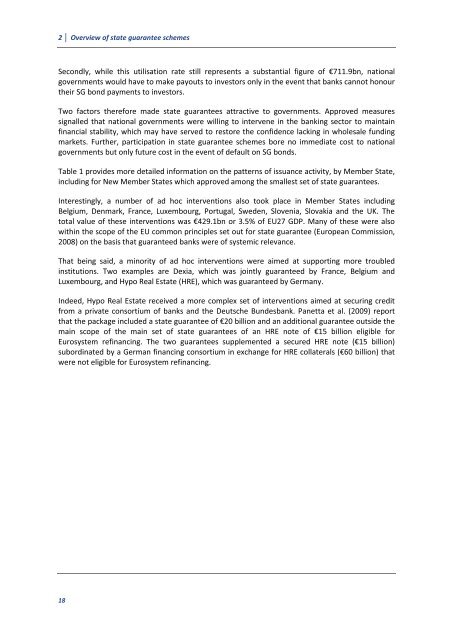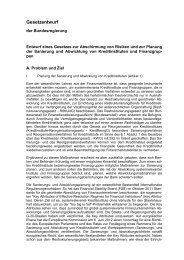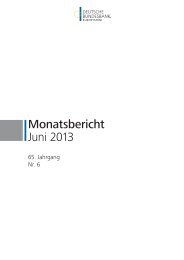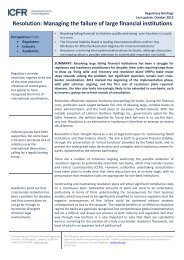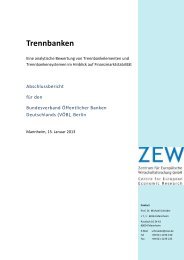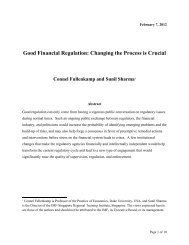3 Issuing costs of state guaranteed bonds - Financial Risk and ...
3 Issuing costs of state guaranteed bonds - Financial Risk and ...
3 Issuing costs of state guaranteed bonds - Financial Risk and ...
Create successful ePaper yourself
Turn your PDF publications into a flip-book with our unique Google optimized e-Paper software.
2 Overview <strong>of</strong> <strong>state</strong> guarantee schemes<br />
Secondly, while this utilisation rate still represents a substantial figure <strong>of</strong> €711.9bn, national<br />
governments would have to make payouts to investors only in the event that banks cannot honour<br />
their SG bond payments to investors.<br />
Two factors therefore made <strong>state</strong> guarantees attractive to governments. Approved measures<br />
signalled that national governments were willing to intervene in the banking sector to maintain<br />
financial stability, which may have served to restore the confidence lacking in wholesale funding<br />
markets. Further, participation in <strong>state</strong> guarantee schemes bore no immediate cost to national<br />
governments but only future cost in the event <strong>of</strong> default on SG <strong>bonds</strong>.<br />
Table 1 provides more detailed information on the patterns <strong>of</strong> issuance activity, by Member State,<br />
including for New Member States which approved among the smallest set <strong>of</strong> <strong>state</strong> guarantees.<br />
Interestingly, a number <strong>of</strong> ad hoc interventions also took place in Member States including<br />
Belgium, Denmark, France, Luxembourg, Portugal, Sweden, Slovenia, Slovakia <strong>and</strong> the UK. The<br />
total value <strong>of</strong> these interventions was €429.1bn or 3.5% <strong>of</strong> EU27 GDP. Many <strong>of</strong> these were also<br />
within the scope <strong>of</strong> the EU common principles set out for <strong>state</strong> guarantee (European Commission,<br />
2008) on the basis that <strong>guaranteed</strong> banks were <strong>of</strong> systemic relevance.<br />
That being said, a minority <strong>of</strong> ad hoc interventions were aimed at supporting more troubled<br />
institutions. Two examples are Dexia, which was jointly <strong>guaranteed</strong> by France, Belgium <strong>and</strong><br />
Luxembourg, <strong>and</strong> Hypo Real E<strong>state</strong> (HRE), which was <strong>guaranteed</strong> by Germany.<br />
Indeed, Hypo Real E<strong>state</strong> received a more complex set <strong>of</strong> interventions aimed at securing credit<br />
from a private consortium <strong>of</strong> banks <strong>and</strong> the Deutsche Bundesbank. Panetta et al. (2009) report<br />
that the package included a <strong>state</strong> guarantee <strong>of</strong> €20 billion <strong>and</strong> an additional guarantee outside the<br />
main scope <strong>of</strong> the main set <strong>of</strong> <strong>state</strong> guarantees <strong>of</strong> an HRE note <strong>of</strong> €15 billion eligible for<br />
Eurosystem refinancing. The two guarantees supplemented a secured HRE note (€15 billion)<br />
subordinated by a German financing consortium in exchange for HRE collaterals (€60 billion) that<br />
were not eligible for Eurosystem refinancing.<br />
18


